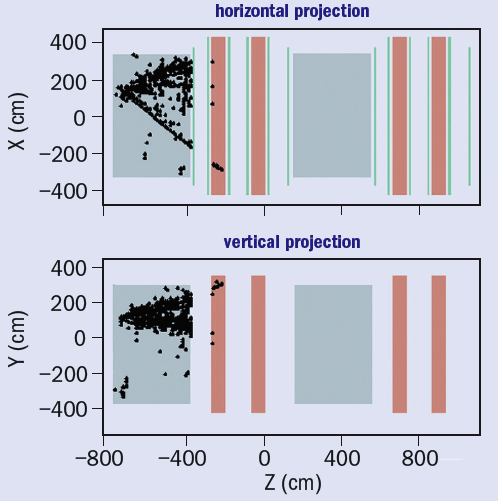For the first time, on 18 August, the OPERA detector in the Gran Sasso Laboratory in Italy recorded the interactions of neutrinos sent from CERN, 732 km away. During the following 11 days, OPERA had about 120 hours of beam time and identified around 300 interactions correlated with the neutrino beam, in-line with predictions. This marked both a successful culmination for the beam-commissioning phase of the CERN Neutrinos to Gran Sasso (CNGS) project and a promising start to data-taking for OPERA. The ultimate aim is to observe oscillations from muon neutrinos into tau neutrinos.

The CNGS beam line incorporates a target to produce pions and kaons and a magnetic horn and reflector to focus them before they decay to muons and neutrinos in a 1 km vacuum pipe. At the end of the decay pipe, a barrier of graphite and iron absorbs the remaining hadrons, leaving only muons, which are quickly absorbed downstream in the rock, and a beam of neutrinos travelling towards Gran Sasso.

The CNGS team began gradually to commission the installation at the start of 2006, beginning with tests without beam of some 200 items of equipment. Then, from 10 July, protons from CERN’s Super Proton Synchrotron were sent step-by-step through the beam line to the target, using a beam 100 times less intense than the nominal beam. After analysis at the end of July, commissioning resumed at high intensity.
The OPERA Collaboration, comprising 170 physicists from 35 research institutes and universities worldwide, began installing their detector in the underground laboratory at Gran Sasso in 2003. The detector has two identical Super Modules, each containing a target section and a large-aperture spectrometer. The target consists of alternate walls of lead/emulsion bricks and modules of scintillator strips for the target tracker. The spectrometer, which detects muons emerging from neutrino interactions, consists of a precision drift-tube tracker, a 1.55 T magnet and resistive plate chambers (RPCs) inserted into the magnet.
During this first run, researchers verified the operation of the electronic detectors (4000 m2 of RPCs, 6000 m2 of scintillator strips and two magnets), checked the synchronization of the OPERA and CNGS clocks and tested the algorithms governing the selection of interesting events. CNGS can send at most two bunches of neutrinos every 6 s, and to reduce the background noise, the experiment has to select events exactly as a bunch passes through. The two 10.5 µs bunches are separated by 50 ms, and the design synchronization accuracy between CERN and OPERA is better than 100 ns.
OPERA is now ready to enter the next phase, aimed at observing neutrino interactions in the emulsions of the detector’s 200,000 target bricks, which will be produced and installed over the coming months. The long search for tau neutrinos will start in earnest at the end of October and will last at least five years.





